|
|
| Übersicht – Contents: | |
Diese Seite ist Teil des Projektes
|
|
| Übersicht – Contents: | |
Flagge – Flag: |
|
 |
Nationalflagge – national flag, Quelle/Source: Wikipedia (EN), Drawn by User:Pumbaa80, User:Achim1999, Public domain, via Wikimedia Commons   |
historische Flaggen – historical Flags: |
|
 |
1930—1962, Nationalflagge – national flag, Quelle/Source: Wikipedia (EN), Orange Tuesday, CC BY-SA 3.0, via Wikimedia Commons |
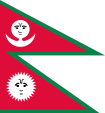 |
1856—1930, Nationalflagge – national flag, Quelle/Source, nach/by: Wikipedia (EN) |
 |
18./19. Jhd./cent., Truppenfahne – Troop flag, Quelle/Source, nach/by: Wikipedia (EN) |
 |
1969, Standarte des Königs – standard of the King, Seitenverhältnis – ratio = 11:8, Quelle/Source, nach/by: Wikipedia (EN), Sodacan, CC BY-SA 4.0, via Wikimedia Commons |
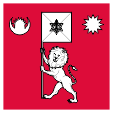 |
2001, Standarte des Königs – standard of the King, Seitenverhältnis – ratio = 1:1, Quelle/Source, nach/by: Wikipedia (EN), Sodacan, CC BY-SA 4.0, via Wikimedia Commons |
| Die heutige Flagge Nepals wurde am 16.12.1962 – im Zusammenhang mit dem Inkrafttreten der neuen Verfassung – eingeführt, nach anderen Quellen jedoch schon am 16.12.1961. Sie ist die einzige nicht rechtwinklige Nationalflagge der Welt, ist oben abgeschrägt und am fliegenden Ende mit einem Einschnitt versehen. Sie zeigt übereinander eine weiße Sonne und einen weißen Mond auf dunkelblau eingerahmtem karminroten Grund. Ihre Wurzeln liegen im 19. Jahrhundert. Die Farben der Flagge scheinen heute folgendermaßen definiert zu sein, und zwar: Blau = HEX #003594, was Pantone 287 entsprechen würde, Rot = HEX #DD0C39, was Pantone 192 entsprechen würde. | The
today's flag of Nepal was introduced on 16th of december in 1962 – in
occasion with the coming into force of the new constitution – by other
sources already on 16th of december in 1961. It is the only non-rectangular national flag in the world, it is above beveled and on the flying end performed with a incision. It shows on top of each other a white sun and a white moon on dark-blue framed carmine ground. The flag has its roots in the 19th century. The colours of the flag seem today to be defined as follows: Blue = HEX #003594, which would correspond to Pantone 287, Red = HEX #DD0C39, which would correspond to Pantone 192. |
Über
Ursprung und Bedeutung der Flagge sowie der Farben gibt es die
unterschiedlichsten Theorien:
|
About the
origin and the meaning of the flag, as soon as of the colours there are
differentest theories:
|
| Vor 1962 zeigten die Abbildungen von Mond und Sonne in der Flagge Gesichter mit Kastenmalen. | Before 1962 the depictions of moon and sun in the flag showed faces with caste marks. |
| Die Flagge des Königs war einfarbig rot mit einem silbernen steigenden Löwen in der Mitte, der eine silberne Flagge hält. In den oberen Ecken, in Silber, Mond und Sonne. Dies könnte ein Widerspruch dazu sein, dass Sonne und Mond Symbole von Familien sind, denn weshalb sollten beide zusammen auf dem Banner des Königs auftauchen? | The flag
of the king was single-coloured red with a silvery mounting lion in the
middle who carrys a silvery flag. In the upper quadrants – in silver – moon
and sun. This could be a contradiction for that, that sun and moon should be symbols of families. Why should both arise together on the banner of the King? |
| Quelle/Source: Flags of the World, Wikipedia (DE), Wikipedia (EN), Volker Preuß | |
Wappen – Coat of Arms: |
|
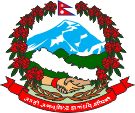 |
seit/since 2007, Wappen von Nepal – coat of arms of Nepal, Quelle/Source: Wikipedia (EN), CAPTAIN MEDUSA, CC BY-SA 4.0, via Wikimedia Commons |
historische Wappen – historical Coat of Arms: |
|
 |
1962–2006, Wappen von Nepal – coat of arms of Nepal, Quelle/Source, nach/by: Wikipedia (EN) |
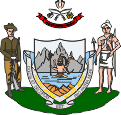 |
1946–1962, Wappen von Nepal – coat of arms of Nepal, Quelle/Source, nach/by: Wikipedia (EN) |
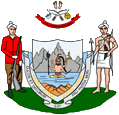 |
1935–1946, Wappen von Nepal – coat of arms of Nepal, Quelle/Source, nach/by: Wikipedia (EN) |
| Das
heutige Staatswappen wurde am 18.05.2008 angenommen und 2020 in Details
abgeändert. Es zeigt innerhalb eines
Kranzes von Rhododendronblüten (Nationalblume) eine stilisierte weiße
Landkarte Nepals vor der Silhouette des Mount Everest und einer
Himalaya-Berglandschaft. Darunter ein Handschlag von Mann und Frau. Unten ein rotes Spruchband mit der weißen Sanskrit-Aufschrift "Janani Janmabhumisca svargadapi Gariyasi" → "Das Heimatland ist teurer als das Himmelreich". |
The
today's coat of arms was adoped on 18th of May in 2008 and was changed in
details in 2020. It shows within a wreath of rhododendron blossoms (national flower) a
stylized white map of Nepal in front of the silhouette of Mount Everest and
an Himalaya mountains scenery. Underneath a shake hands of man and wife. Below a red banner with the white sanskrit-inscription "Janani Janmabhumisca svargadapi Gariyasi" → "The homeland is expensiver than the heavenly empire". |
| Dieses Wappen zeigt im Vergleich zu seinem Vorgänger keine Königskrone mehr. Ein Zeichen für die durch die neue Verfassung abgeschaffte Macht des Königs. | That coat of arms shows in comparison with its predecessor none crown of a king anymore. A sign of the by the new constitution abolished royal power. |
| Das zwischen 1962 und 2007 gültige Staatswappen zeigte als Hauptbestandteil eine nepalesische Landschaft mit den Himalajabergen im Hintergrund, einer weißen Kuh, einem Fasan und Rhododendronblüten. Unten war ein rotes Spruchband mit der Sanskrit-Aufschrift "Das Heimatland ist teurer als das Himmelreich". Links und rechts als Schildhalter standen je ein Gurkhasoldat in moderner und historischer Uniform. Oben zwei Khukuri-Dolche, zwei nepalesische Flaggen, die Fußspuren Gorakhnaths (des Gottes der Gurkhas), und die Königskrone als Symbol der damals wiedererrichteten absoluten Monarchie. | The between 1962 und 2007 valid coat of arms of the state showed as main-component a Nepalese landscape with the Himalaja mountains in the background, a white cow, a pheasant and rhododendron blossoms. Below was a red banner with the sanskrit-inscription "The homeland is expensiver than the heavenly empire". To the left and on the right stood as supporters ever one gurkha-soldier in modern and historical uniforms. Above two Khukuri daggers, two Nepalese flags, the treads of Gorakhnath (the god of the gurkhas), and the crown of the King as a symbol of the then re-established absolute monarchy. |
| Bis zum 16.12.1962 verwendete Nepal ein Wappen, in dessen Schild der Hindugott Shiva zu sehen war, der vor den Bergen des Himalaya aus dem Meer aufsteigt. Oberhalb des Schildes zwei Khukuri-Dolche, Mond und Sonne und die Fußspuren Gorakhnaths, des Gottes der Gurkha, sowie ein rotes Spruchband. Um das Wappenschild befanden sich zwei weiße Spruchbänder. In dem inneren das Staatsmotto in goldenen Sanskrit-Buchstaben "Janani Janmabhumisca svargadapi Gariyasi" → "Das Heimatland ist teurer als das Himmelreich". Das äußere Spruchband zeigte in schwarzen Buchstaben ein weiteres Motto, und zwar in Latein: "DULCIS ET DECORUM EST PRO PATRIA MORI" → "Es ist süß und ehrenvoll für das Vaterland zu sterben", eine Hommage an die berühmten Gurkha-Truppen, die in der britischen Armee dienten und bis heute dienen. Schildhalter waren zwei Gurkha-Soldaten in Britischer und traditioneller Uniform. | Until the
16th of December in 1962 Nepal used a coat of arms in its shield was to see
the Hindu-God Shiva arising from the sea in front of the mountains of the
Himalaya. Above the shield two Khukuri daggers, moon and sun and the treads of Gorakhnath – the god of the Gurkha, as well as a red banner. Around the blazon were placed two white banners. In the inner the motto of the state in golden Sanskrit letters "Janani Janmabhumisca svargadapi Gariyasi" → "The homeland is expensiver than the heavenly empire". The outer banner showed in black letters an other motto, so in Latin: "DULCIS ET DECORUM EST PRO PATRIA MORI" → "It is sweet and honorable to die for the Fatherland", an homage to the famous Gurkha-Troops which served in the British army and serve until today. Shield supporters were two Gurkha-Soldiers in British and traditional uniform. |
| Quelle/Source: Flags of the World, Wikipedia (DE), Flaggen Wappen Hymnen, Volker Preuß | |
Flugzeugkokarde – aircraft roundel: |
|
 (?) |
Flugzeugkokarde – aircraft roundel Quelle/Source, nach by: Flags of the World |
Landkarte – Map: |
Lage – Position: |
Landkarte des Landes – Map of the Country: |
|
|
| Zahlen und Fakten – Numbers and Facts: | |
|
|
|
|
|
|
|
|
|
|
|
|
|
|
|
|
|
|
|
|
|
| Antike ·
Besiedlung durch tibetische Stämme ca. 250 · der Stamm der Mewari gründet um Katmandu das Fürstentum Malla ca. 650 · das Fürstentum Malla wird vom tibetischen Turfanreich abhängig ca. 1150 · Malla wird wieder unabhängig 1386–1429 · Einführung des Kastensystems, in den Folgejahren zerfällt das Fürstentum Malla in kleinere Staaten ca. 1730 · das Volk der Gurkha beginnt die Region zu erobern, Herausbildung eines Gurkha-Fürstentums 1756 · die keineren tibetischen Fürstentümer werden unter dem Gurkha-Fürsten Narayan vereinigt, als Landesname setzt sich Nepal durch 1767 · militärischer Eroberungsversuch der Britischen Ostindienkompanie 1787 · Nepal erreicht seine größte Ausdehnung, von Kaschmir bis nach Sikkim 1793 · Handelsabkommen mit Großbritannien 1793 · Nepal muss die Oberhoheit Chinas anerkennen, Tributzahlungen an China bis 1908 1801 · Nepal schließt einen Schutzvertrag mit Großbritannien 1814 · China verstärkt seinen Einfluss in Nepal, die Britische Ostindienkompanie lässt das Land daraufhin militärisch besetzen 02.12.1815 · Friedensvertrag von Segauli, Nepal muss Teile des Landes an Britisch-Indien abtreten und die britische Oberhoheit anerkennen 1846 · die Familie Rana putscht sich in das Amt des Premierministers und macht es dynastisch erblich, das Königtum der Familie Bir Bikram wird politisch unbedeutend 1854 · militärische Auseinandersetzungen mit Tibet 1856 · Nepal erhält Handelsprivilegien in Tibet 1920 · erste Forderungen zum Sturz der Familie Rana nach Einführung der konstitutionellen Monarchie 1947 · Gründung des Nepalesischen Nationalkongresses 1950 · König Tribhuvan (Tribhavana Bir Bikram Dschung Bahadur, 1911–1955) lässt in Indien eine Befreiungsarmee des Nepalesischen Nationalkongresses aufstellen die in Nepal einmarschiert und die Familie Rana stürzt Januar 1951 · Einführung der konstitutionellen Monarchie nach indischem Vorbild, die Familie Rana stellt in der Regierung den Ministerpräsident November 1951 · König Tribhuvan löst die bisherige Regierung auf, und bestellt ein Kabinett des Nepalesischen Nationalkongresses 1955 · Tod von König Tribhuvan, Nachfolger wird sein Sohn Mahendra 1959 · erste demokratische Wahlen, Sieg des Nepalesischen Nationalkongresses 1960 · König Mahendra löst das Parlament auf und verbietet die Parteien, die Verfassung wird aufgehoben und einseitige Bindung an Indien beendet 1962 · Einführung einer neuen Verfassung nach pakistanischem Vorbild mit dem sogenannten Dorfräte-System (Panchayat-System: keine Parteien, überwiegend indirekte Wahlen) 1972 · Tod von König Mahendra, Nachfolger wird sein Sohn Birendra 1979 · innere Unruhen gegen das Panchayat-System 1980 · König Birendra lässt eine Volksabstimmung über Panchayat-System durchführen, die einer Mehrheit dafür ergab 1989 · Indien verhängt eine politisch motivierte Handelsblockade gegen Nepal 1990 · blutige Unruhen durch sogenannte Demokratie- und Menschenrechtsbewegungen, König Birendra führt eine neue Verfassung ein, welche die konstitutionelle Monarchie wiederherstellt und das Panchayat-System durch ein Mehrparteiensystem ersetzt 01.06.2001 · König Birendra, Königin Aishwarya und sieben weitere Mitglieder der königlichen Familie sterben im Königspalast in Katmandu von der Hand des Kronprinzen Dipendra, der Selbstmord begeht 04.06.2001 · Birendras jüngerer Bruder Gyanendra wird zum neuen König proklamiert 2002 · Auflösung des Parlaments durch den König 2006 · Generalstreik, infolge dessen Wiedereinsetzung des Parlaments, das Parlament entzieht dem König die Exekutivgewalt, er nimmt nur noch repräsentative Aufgaben wahr 28.12.2007 · das Parlament beschließt die Abschaffung der Monarchie 28.05.2008 · Abschaffung der Monarchie, Proklamation der Republik September 2025 · gewalttätige Unruhen führen zum Sturz der Regierung |
| Antiquity
· settlement by Tibetan tribes ca. 250 · the tribe of the Mewari establishes around Katmandu the Principality of Malla ca. 650 · the Principality of Malla becomes dependent from the Tibetan Turfan Empire ca. 1150 · Malla becomes independent again 1386–1429 · introduction of the caste system, in the afteryears disintegrates the Principality of Malla in smaller states ca. 1730 · the Gurkha people starts to conquer the region, establishment of a Gurkha Principality 1756 · the smaller Tibetan Principalities become unifyed under the Gurkha Prince Narayan, as name of the land achieves Nepal 1767 · military attempt of conquer by the British East Indian Company 1787 · Nepal reaches its largest dimension, from Kashmir to Sikkim 1793 · Agreement of trade with United Kingdom 1793 · Nepal has to recognize the supremacy of China, tribute payments to China until 1908 1801 · Nepal associates with United Kingdom by a treaty of protection 1814 · China intensifys its influence in Nepal, the British East Indian Company keeps occupy the country militarily because of that 2nd December 1815 · Peace Treaty of Segauli, Nepal has to cede parts of the country to British India and has to recognize the britische supremacy 1846 · the Rana familiy revolts into the function of the prime minister and makes it dynastic and heritable, the kingship of the family Bir Bikram becomes political insignificant 1854 · military quarrels with Tibet 1856 · Nepal gets trade privileges in Tibet 1920 · first demands to overthrow the Rana Family and for introduction of the constitutional monarchy 1947 · foundation of the Nepalese National Congress 1950 · King Tribhuvan (Tribhavana Bir Bikram Dschung Bahadur, 1911–1955) keeps to convene a liberation army of the Nepalese National Congress in India which invades in Nepal and overthrows the Rana Family January 1951 · introduction of the constitutional monarchy by Indian pattern, the Rana Family has in the government the position of the premier November 1951 · King Tribhuvan dissolves the hitherto government and convenes a cabinet of the Nepalese National Congress 1955 · death of von King Tribhuvan, successor is his son Mahendra 1959 · first democratic elections, victory of the Nepalese National Congress 1960 · King Mahendra dissolves the parliament and prohibits the parties, the constitution becomes annuled and the unilateral allegiance with India becomes terminated 1962 · introduction of a new constitution by Pakistani pattern with the so named village-counsel-system (Panchayat-System: no parties, prevalent indirect elections) 1972 · death of von King Mahendra, successor is his son Birendra 1979 · interior roits against the Panchayat-System 1980 · King Birendra keeps to perform a plebiscite about the Panchayat-System which results a majority for that 1989 · India imposes a political motivated trade blockade against Nepal 1990 · bloody roits by so named Democracy and Human Rights Movements, King Birendra introduces a new constitution which reestablishes the constitutional monarchy and substitutes the Panchayat-System by a multi-party-system 1st of June 2001 · King Birendra, Queen Aishwarya and seven further memebers of the royal family perish in the king's palace in Katmandu by the hand of the crown prince Dipendra, committing suicide 4th of June in 2001 · Gyanendra – the younger brother of Birendra – becomes proclaimed to the new King 2002 · dissolution of parliament by the King 2006 · general strike, as a result of which parliament is reinstated, parliament removes executive power from the King, who now only performs representative duties 28th of Dezember 2007 · parliament decides to abolish the monarchy 28th of May 2008 · abolition of the monarchy, proclamation of the republic September 2025 · violent uprisings lead to the fall of the government |
| Quelle/Source: Atlas zur Geschichte, World Statesmen, Weltgeschichte, Discovery '97, Wikipedia (D) |
| Der Name "Nepal" geht auf die Sanskrit-Worte "nipat → hinabfliegen" und "alaya → Wohnstätte" zurück. Gemeint sind also die an den Berghängen des Himalaya klebenden Dörfer. | The name
"Nepal" has is roots in the Sanskrit words "nipat → down flying" and "alaya
→ habitation". That intends the on the mountainsides of the Himalaya gluing
villages. |
| Quelle/Source: Handbuch der geographischen Namen | |